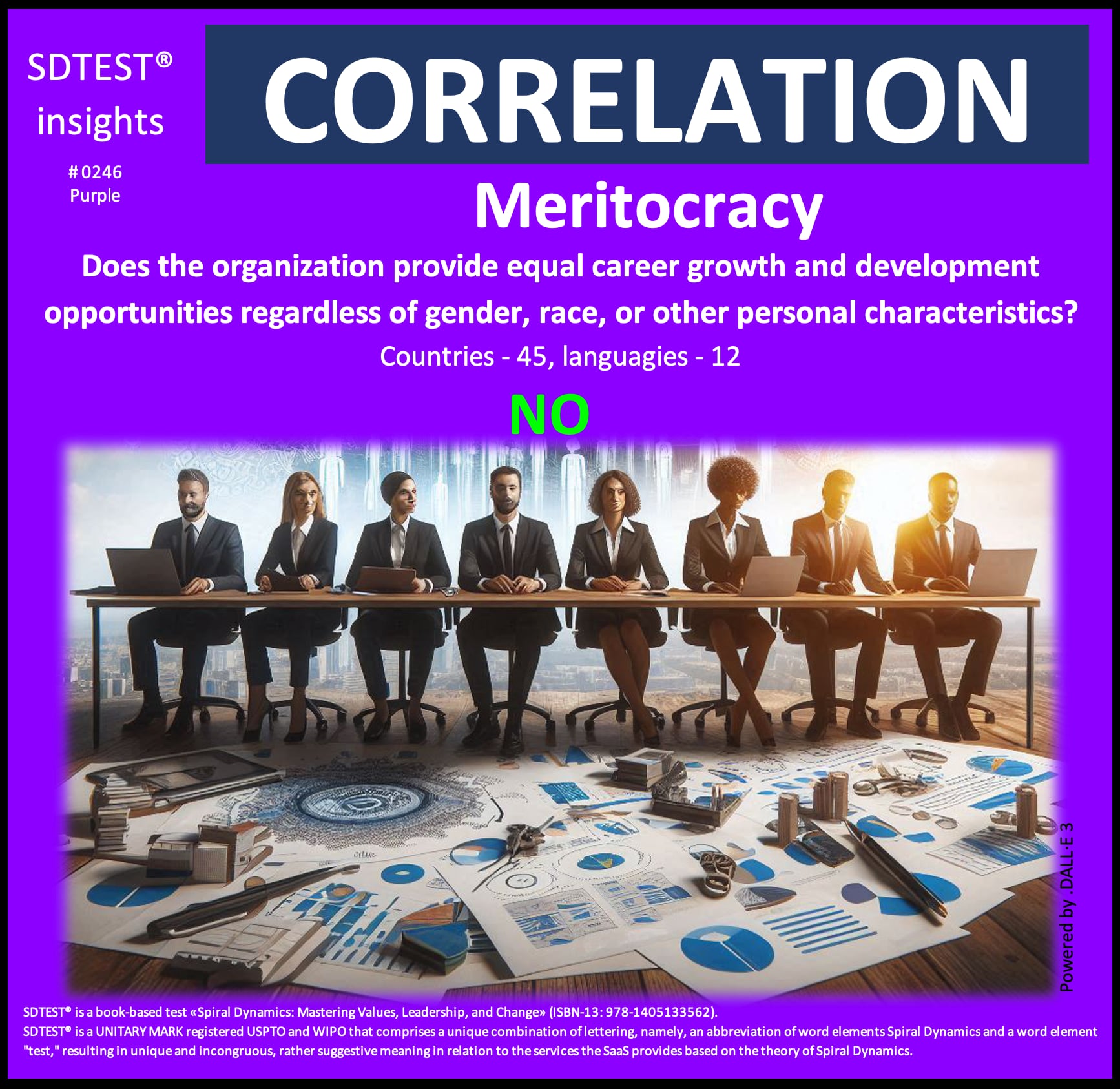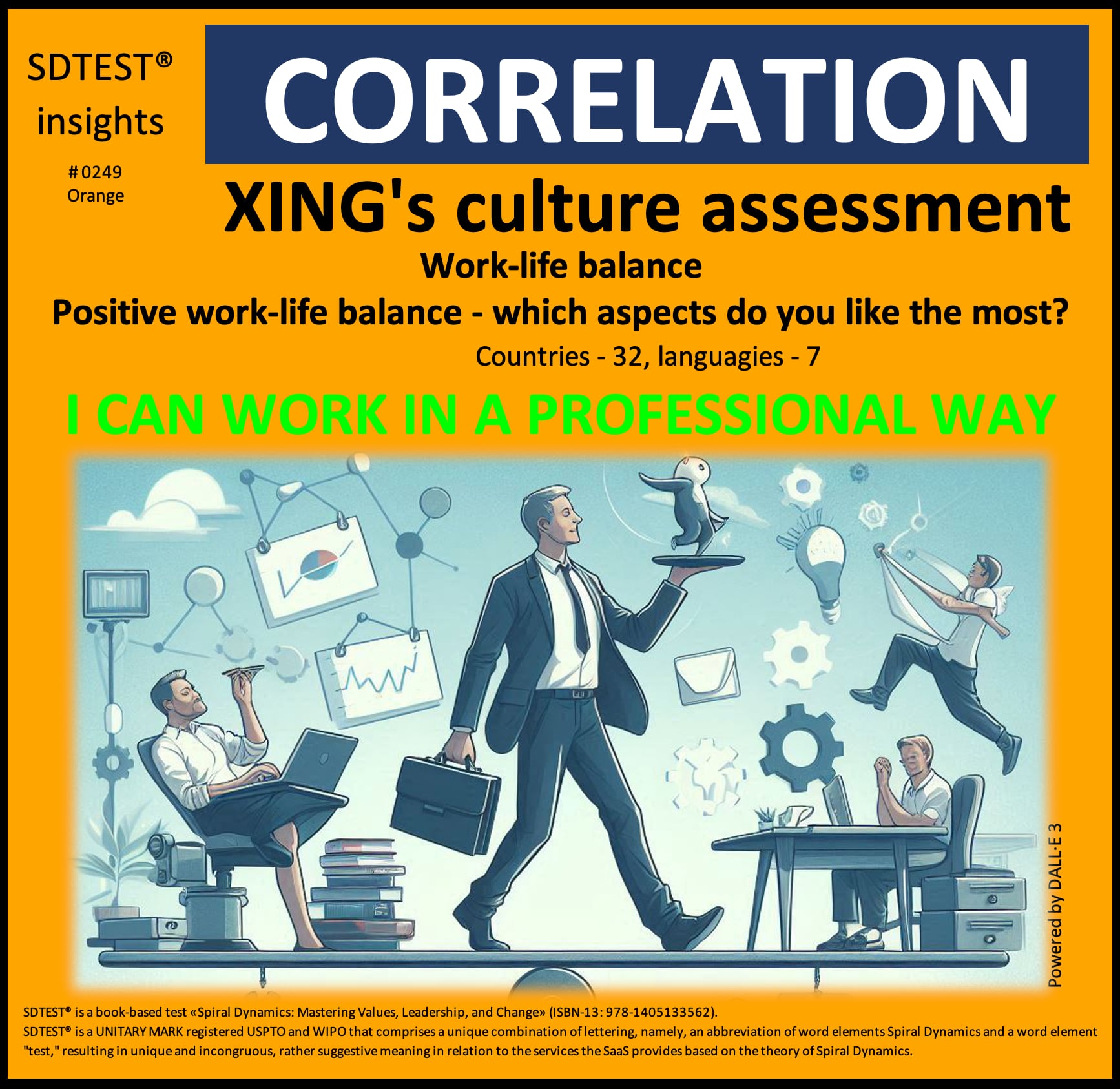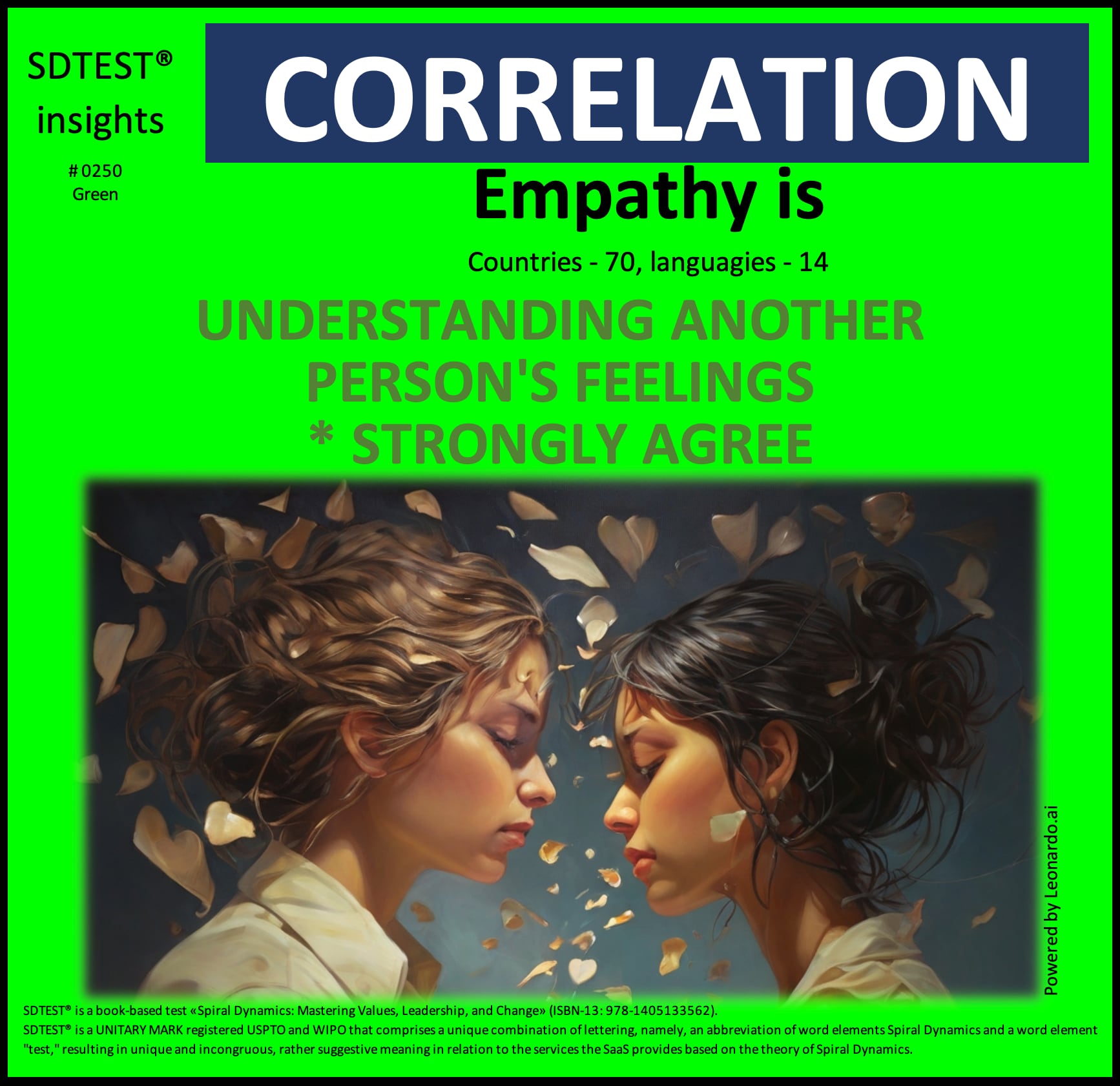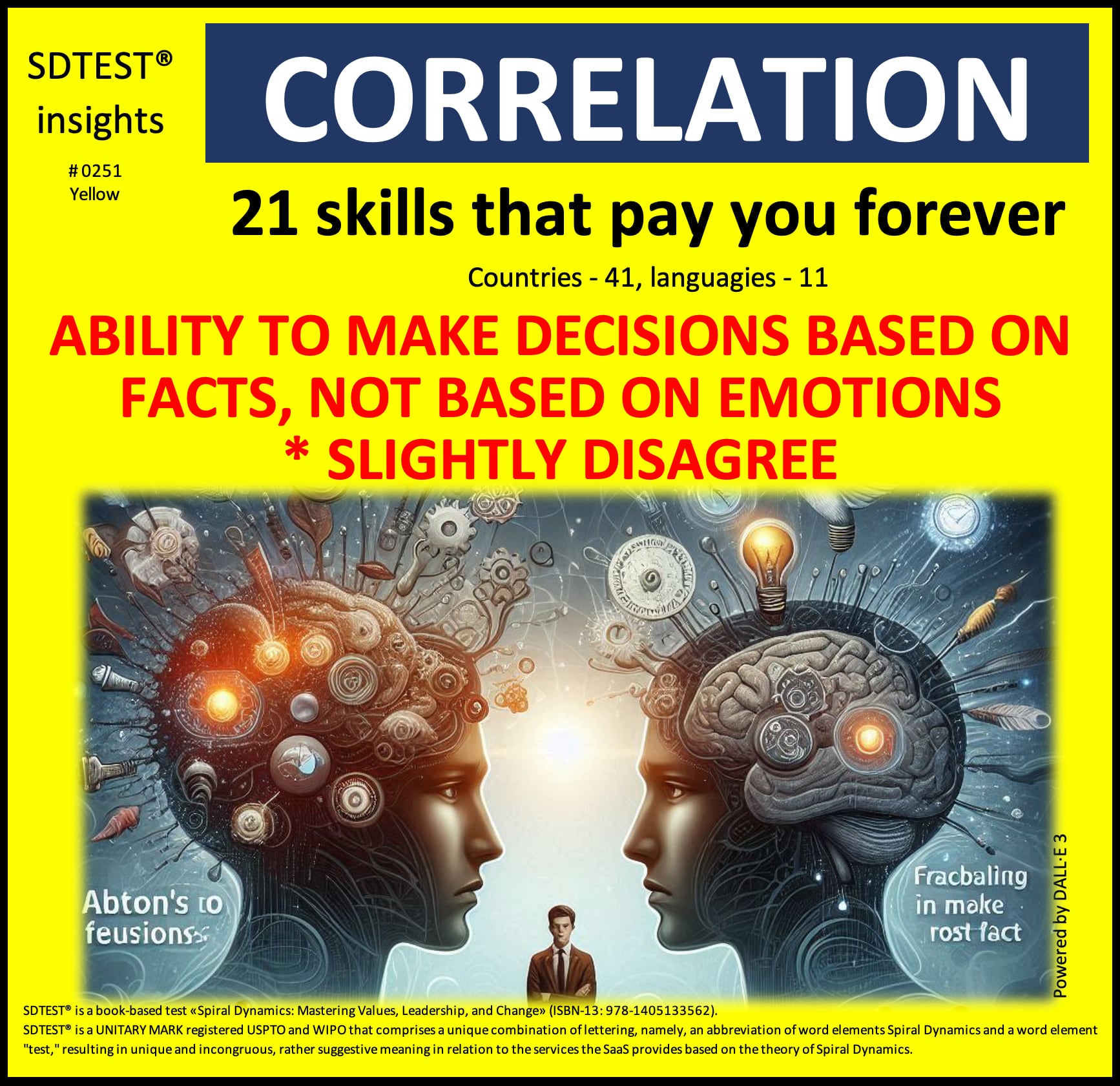SDTEST® has 36 different VUCA polls that calculate the 13,034 correlation values between stages of development according to the theory of Spiral Dynamics and answer options of these 36 polls.
We invite curiosity about the systemic mechanisms behind this correlation. There may be hidden variables that provide alternative explanations.
In our analysis of the poll "Meritocracy" (Does the organization provide equal career growth and development opportunities regardless of gender, race, or other personal characteristics?), we found an intriguing positive correlation that warrants closer examination:
0.0630 between the NO and the Purple stage.
The critical value of the correlation coefficient for a non-normal distribution, by Spearman r = 0.008. This positive correlation of 0.0630 meets the reliability criteria but does not necessarily imply causation.

This positive correlation of 0.0630 between perceiving a lack of equal career opportunities and the Purple stage offers intriguing insights when viewed through the lens of the Purple value system:
Organizational Perspective:
Organizations operating within the Purple mindset might interpret this correlation as:
- Validation of their traditional hierarchical structures based on ancestral or spiritual authority.
- Confirmation that career advancement should align with established tribal or clan-based norms.
- Justification for maintaining time-honored practices that may favor certain groups over others.
These organizations might respond by:
- Reinforcing leadership roles based on lineage or spiritual significance rather than merit.
- Implementing rituals and ceremonies to mark career advancements within the tribal structure.
- Emphasizing the importance of adhering to ancestral wisdom in career development.
Team Perspective:
Teams operating from a Purple mindset might approach this correlation by:
- Viewing it as support for maintaining established team hierarchies and roles.
- Interpreting it as a call to strengthen in-group bonds and traditions within the team.
- Seeing it as confirmation that team advancement should follow sacred or ancestral patterns.
These teams might respond by:
- Assigning roles and responsibilities based on perceived spiritual or ancestral connections.
- Implementing team rituals that reinforce traditional power structures and relationships.
- Discouraging individual ambition that challenges established team dynamics.
Individual Perspective:
Individuals aligned with the Purple value system might interpret this correlation as:
- Personal validation of their belief in predetermined roles and destinies.
- Justification for seeking career advancement through spiritual or ancestral connections.
- Confirmation that higher powers determine one's place in the organizational hierarchy.
These individuals might respond by:
- Seeking guidance from spiritual leaders or ancestral wisdom for career decisions.
- Accepting their position as part of a greater cosmic or tribal order.
- Prioritizing group harmony and adherence to traditions over personal career ambitions.
This correlation, viewed through the Purple lens, suggests that those operating at the Purple level may be more likely to perceive and accept unequal career opportunities as part of the natural order. It implies that the Purple value system's characteristics of tradition, spirituality, and group identity align with a worldview that may not prioritize equal opportunities in the modern sense.
From this perspective, the correlation invites us to explore the interplay between traditional belief systems and perceptions of career equity. It prompts us to ask How Purple-oriented values influence the understanding of fairness and opportunity in the workplace. What role do ancestral traditions and spiritual beliefs play in shaping career expectations and development?
This perspective challenges us to consider the following:
- How can organizations balance respect for traditional values with the need for equitable practices?
- What role might rituals and spiritual practices play in creating a sense of belonging and purpose in the workplace?
- How can we address the potential conflict between Purple-oriented worldviews and modern concepts of equal opportunity?
By recognizing this tendency in Purple-oriented contexts, we gain insight into potential barriers to implementing equal opportunity policies in specific cultural settings. This understanding can be crucial for developing sensitive, culturally aware approaches to promoting fairness and equity in diverse organizational environments.
In essence, this correlation suggests that perceptions of career opportunities are deeply intertwined with spiritual beliefs, ancestral traditions, and group identities for those in the Purple value system. It underscores the need for nuanced, culturally informed approaches to addressing equity issues in organizations where Purple values are prevalent, recognizing that concepts of fairness and opportunity may be understood differently in these contexts.
Ultimately, this correlation shows the complex relationship between value systems and organizational practices. It reminds us that in the Purple worldview, career growth and opportunities may be seen as predetermined by higher powers or ancestral traditions rather than based on individual merit or equal opportunity policies.
In our analysis of the poll "Why do people procrastinate?" we found an intriguing positive correlation that warrants closer examination:
0.0680 between the Exhaustion: Feeling physically or mentally drained makes initiating or completing tasks challenging / Highly Applicable and the Red stage.
The critical value of the correlation coefficient for a non-normal distribution, by Spearman r = 0.003. This positive correlation of 0.0680 meets the reliability criteria but does not necessarily imply causation.

This positive correlation of 0.0680 between Exhaustion making it challenging to initiate or complete tasks and the Red stage offers intriguing insights when viewed through the lens of the Red value system:
Organizational Perspective:
Organizations operating within the Red mindset might interpret this correlation as:
- A sign of weakness in their ranks that needs to be purged for the organization to maintain dominance.
- An opportunity to identify and promote the most resilient and power-hungry individuals.
- Justification for implementing harsh, survival-of-the-fittest policies to weed out the weak.
These organizations might respond by:
- Implementing grueling work schedules to test employees' endurance and willpower.
- Rewarding those who push through exhaustion with more power and resources.
- Publicly shaming or demoting individuals who succumb to exhaustion-induced procrastination.
Team Perspective:
Teams operating from a Red mindset might approach this correlation by:
- Viewing it as a challenge to prove their superiority over other teams by overcoming exhaustion.
- Interpreting it as an opportunity to establish a hierarchy based on who can push through fatigue.
- Seeing it as a way to identify the most vital, most dominant team members.
These teams might respond by:
- Engaging in high-stakes competitions to see who can work the longest without breaks.
- Ostracizing team members who show signs of exhaustion or procrastination.
- Celebrating aggressive, "no excuses" attitudes towards task completion.
Individual Perspective:
Individuals aligned with the Red value system might interpret this correlation as:
- A personal challenge to overcome, proving their superiority over weaker individuals.
- An opportunity to assert dominance by pushing their limits beyond exhaustion.
- Justification for their impulsive, action-oriented approach to tasks.
These individuals might respond by:
- Boasting about their ability to work tirelessly and mocking those who can't keep up.
- Seeking ways to enhance their stamina through any means necessary, regardless of health consequences.
- Aggressively taking on more tasks to prove their worth and power within the organization.
This correlation, viewed through the Red lens, suggests that those operating at the Red level may see exhaustion as a barrier to be conquered rather than a valid reason for procrastination. The Red value system's characteristics of impulsiveness, self-centeredness, and desire for immediate gratification may drive individuals to push beyond their limits, potentially at the cost of long-term well-being.
Ultimately, this correlation shows the complex relationship between human values and productivity. It reminds us that in the Red worldview, the potential for immediate power and dominance through relentless action may outweigh sustainable work practices or personal well-being considerations.
In our analysis of the poll "Gender difference in building self-confidence" (by IFD Allensbach), we found an intriguing positive correlation that warrants closer examination:
0.1262 between the Earnings and the Blue stage.
The critical value of the correlation coefficient for a normal distribution, by William Sealy Gosset (Student) r = 0.116. This positive correlation of 0.1262 meets the reliability criteria but does not necessarily imply causation.

This positive correlation of 0.1262 between Earnings and the Blue stage in the context of gender differences in building self-confidence offers intriguing insights when viewed through the lens of the Blue value system:
Organizational Perspective:
Organizations operating within the Blue mindset might interpret this correlation as:
- Validation of their hierarchical structure where earnings reflect one's position and adherence to organizational rules.
- Confirmation that their system of rewarding loyalty and conformity through compensation is effective.
- Evidence supports the traditional view that earnings measure one's contribution to the established order.
These organizations might respond by:
- Reinforcing pay structures that clearly delineate levels of authority and responsibility.
- Implementing stricter policies to ensure fair and consistent earnings based on established criteria.
- Emphasizing the importance of following proper channels for career advancement and increased earnings.
Team Perspective:
Teams operating from a Blue mindset might approach this correlation by:
- Viewing it as an affirmation of the importance of team members fulfilling their designated roles.
- Interpreting it as support for maintaining clear team hierarchies based on earnings.
- Seeing it as justification for promoting team members who best embody the organization's values.
These teams might respond by:
- Establishing more explicit guidelines for earnings-based roles and responsibilities within the team.
- Encouraging team members to focus on dutiful performance rather than individual achievement.
- Implementing mentorship programs to guide team members in aligning their career paths with organizational values.
Individual Perspective:
Individuals aligned with the Blue value system might interpret this correlation as:
- Confirmation that following rules and traditions leads to rightful rewards in the form of earnings.
- Validation of the belief that self-confidence should be built on one's contribution to the established order.
- Evidence that adhering to societal and organizational norms regarding gender roles is beneficial.
These individuals might respond by:
- Redoubling efforts to conform to organizational expectations to increase earnings and self-confidence.
- Seeking guidance from authority figures on proper conduct for career advancement.
- Advocating for traditional gender roles in the workplace to maintain order and clear expectations.
This correlation, viewed through the Blue lens, suggests that those operating at the Blue level may see earnings as a just reward for adherence to established norms and fulfilling one's duty. It implies that the Blue value system's characteristics of order, discipline, and respect for hierarchy align with the idea that earnings reflect one's proper place in the societal and organizational structure.
Ultimately, this correlation shows the complex relationship between societal values, economic systems, and individual self-perception. It reminds us that in the Blue worldview, earnings may be seen not just as financial compensation but as a reflection of one's commitment to upholding the established order and fulfilling one's designated role in society.
In our analysis of the poll "XING's culture assessment" (Work-life balance. Positive work-life balance - which aspects do you like the most?), we found an intriguing positive correlation that warrants closer examination:
0.1820 between the I can work in a professional way and the Orange stage.
The critical value of the correlation coefficient for a normal distribution, by William Sealy Gosset (Student) r = 0.1659. This positive correlation of 0.1820 meets the reliability criteria but does not necessarily imply causation.

This positive correlation of 0.1820 between the ability to work in a professional way and the Orange stage offers intriguing insights when viewed through the lens of the Orange value system:
Organizational Perspective:
Organizations operating within the Orange mindset might interpret this correlation as:
- Validation of their focus on efficiency, productivity, and results-driven strategies.
- Confirmation that promoting a professional work environment leads to improved performance and goal achievement.
- Evidence supporting their investment in technological tools and scientific management practices.
These organizations might respond by:
- Implementing more advanced performance metrics to quantify and optimize professional behavior.
- Investing in cutting-edge training programs to enhance employees' professional skills and competencies.
- Redesigning workspaces to foster a more professional atmosphere conducive to productivity and innovation.
Team Perspective:
Teams operating from an Orange mindset might approach this correlation by:
- Viewing it as an affirmation of the importance of maintaining high professional standards within the team.
- Interpreting it as support for implementing more sophisticated project management methodologies.
- Seeing it as justification for promoting team members who demonstrate the most professional and results-oriented attitudes.
These teams might respond by:
- Adopting advanced collaboration tools to streamline professional communication and task management.
- Peer review systems are continuously implemented to improve professional standards within the team.
- Organizing regular strategy sessions to set ambitious, measurable goals for professional development and project outcomes.
Individual Perspective:
Individuals aligned with the Orange value system might interpret this correlation as:
- Confirmation that cultivating a professional demeanor is key to personal success and career advancement.
- Validation of their belief in continuous self-improvement and skill development.
- Evidence that their focus on rationality and results-oriented behavior is the right approach for the modern workplace.
These individuals might respond by:
- Investing in personal branding and professional development courses to enhance market value.
- Seeking out mentorship opportunities with successful professionals in their field.
- Adopting productivity apps and time management techniques to maximize their professional efficiency.
This correlation, viewed through the Orange lens, suggests that those operating at the Orange level see professionalism as a key driver of success and progress. It implies that the Orange value system's characteristics of rationality, goal orientation, and focus on measurable results align well with the concept of professional work conduct.
Ultimately, this correlation shows the complex relationship between societal values, work culture, and individual performance. It reminds us that in the Orange worldview, professionalism is about adhering to standards and leveraging them to drive innovation, efficiency, and measurable success in a competitive environment.
In our analysis of the poll "Empathy is", we found an intriguing positive correlation that warrants closer examination:
0.0756 between the Understanding another person's feelings / Strongly Agree and the Green stage.
The critical value of the correlation coefficient for a normal distribution, by William Sealy Gosset (Student) r = 0.0719. This positive correlation of 0.0756 meets the reliability criteria but does not necessarily imply causation.

This positive correlation of 0.0756 between strongly agreeing that empathy is understanding another person's feelings and the Green stage offers intriguing insights when viewed through the lens of the Green value system:
Organizational Perspective:
Organizations operating within the Green mindset might interpret this correlation as:
- Validation of their focus on creating a compassionate and inclusive workplace culture.
- Confirmation that prioritizing emotional intelligence and interpersonal understanding leads to a more harmonious organizational ecosystem.
- Evidence supporting their investment in programs that foster empathy and mutual understanding among employees.
These organizations might respond by:
- Implementing more comprehensive empathy training programs across all levels of the organization.
- Redesigning performance evaluation systems to emphasize empathetic leadership and collaboration.
- Establishing "empathy circles" or similar initiatives to promote deeper understanding among diverse groups within the organization.
Team Perspective:
Teams operating from a Green mindset might approach this correlation by:
- Viewing it as an affirmation of the importance of creating a supportive, empathetic team environment.
- Interpreting it as support for implementing more inclusive decision-making processes that consider all team members' perspectives.
- Seeing it as justification for dedicating more time to team-building activities that enhance mutual understanding.
These teams might respond by:
- Adopting communication practices that encourage active listening and emotional sharing.
- Implementing peer support systems where team members can discuss personal and professional challenges.
- Organizing regular retreats or workshops focused on deepening empathetic connections within the team.
Individual Perspective:
Individuals aligned with the Green value system might interpret this correlation as:
- Confirmation that their focus on developing empathy is aligned with a more advanced stage of consciousness.
- Validation of their belief in the importance of emotional connections in both personal and professional spheres.
- Evidence that cultivating a deep understanding of others' feelings is crucial for personal growth and societal progress.
These individuals might respond by:
- Engaging in mindfulness practices enhances their empathy and emotional awareness capacity.
- Seeking diverse perspectives and experiences to broaden their understanding of others' feelings.
- Advocating for more empathy-centered approaches in their workplaces and communities.
This correlation, viewed through the Green lens, suggests that those operating at the Green level see empathy as a fundamental aspect of human interaction and societal development. It implies that the Green value system's holistic thinking, community focus, and concern for all beings align strongly with a deep understanding of empathy.
Ultimately, this correlation shows the complex relationship between individual emotional capabilities and broader societal values. It reminds us that empathy is a personal skill and crucial to creating a more compassionate, sustainable, and interconnected world in the Green worldview.
In our analysis of the poll "21 skills that pay you forever" (by Jeremiah Teo / 赵汉昇 [1]), we found an intriguing negative correlation that warrants closer examination:
-0.1721 between the Ability to make decisions based on facts, not based on emotions. / Slightly Disagree and the Yellow stage.
The critical value of the correlation coefficient for a normal distribution, by William Sealy Gosset (Student) r = 0.1592. This negative correlation of -0.1721 meets the reliability criteria but does not necessarily imply causation.

This correlation of -0.1721 between slightly disagreeing that the ability to make decisions based on facts, not emotions, is a skill that pays you forever, and the Yellow stage effectively indicates a positive relationship between fact-based decision-making and the Yellow value system.
Organizational Perspective:
Companies operating within the Yellow mindset might interpret this correlation as:
- Validate their approach that values fact-based decision-making while recognizing the complexity of human cognition.
- Confirmation that developing solid analytical skills remains crucial, even as they integrate multiple perspectives.
- Evidence supporting their investment in data-driven processes alongside systems thinking.
These organizations might respond by:
- Implementing advanced data analytics and AI tools to enhance fact-based decision-making capabilities.
- Designing training programs that strengthen employees' ability to critically evaluate information and recognize cognitive biases.
- Fostering a culture that prizes evidence-based practices while maintaining awareness of systemic complexities.
Team Perspective:
Teams operating from a Yellow mindset might approach this correlation by:
- Viewing it as an affirmation of the need for robust analytical skills within a broader context of systems understanding.
- Interpreting it as support for developing more sophisticated data-driven group decision-making processes.
- Seeing it as justification for balancing fact-based approaches with an appreciation for emergent properties in complex systems.
These teams might respond by:
- Adopting advanced data visualization tools to better communicate factual information across diverse perspectives.
- Implementing regular "fact-checking" sessions to ensure decisions are grounded in verifiable data.
- Organizing workshops on distinguishing between facts, interpretations, and emotional responses in team discussions.
Individual Perspective:
Individuals aligned with the Yellow value system might interpret this correlation as:
- Confirmation that honing fact-based decision-making skills is crucial for navigating complex systems.
- Validation of their approach to integrate analytical solid capabilities with broader systems thinking.
- Evidence that cultivating the ability to discern and prioritize factual information is vital for long-term success.
These individuals might respond by:
- Engaging in practices that enhance their critical thinking and data analysis skills.
- Seeking out opportunities to apply fact-based decision-making in diverse and complex scenarios.
- Developing metacognitive skills to understand better how they integrate factual analysis within their holistic worldview.
This correlation, viewed through the Yellow lens, suggests that those operating at the Yellow level recognize the importance of fact-based decision-making as a foundational skill, even when navigating complex systems. It implies that the Yellow value system's integration characteristics and multiple perspective-taking are built upon a solid base of analytical capabilities.
Ultimately, this correlation speaks to the sophisticated relationship between analytical skills and advanced stages of cognitive development. It reminds us that in the Yellow worldview, the ability to make decisions based on facts is not at odds with systems thinking or emotional intelligence. Instead, it forms a crucial component of a more comprehensive approach to understanding and navigating our complex world.
0.2359 between the Project and responsibilities and the Turquoise stage.
The critical value of the correlation coefficient for a normal distribution, by William Sealy Gosset (Student) r = 0.2301. This positive correlation of 0.2359 meets the reliability criteria but does not necessarily imply causation.

This positive correlation of 0.2359 between the importance of project and responsibilities in job selection for IT specialists and the Turquoise stage offers intriguing insights when viewed through the lens of the Turquoise value system:
Organizational Perspective:
Companies operating within the Turquoise mindset might interpret this correlation as:
- Validation of their holistic approach to project design and responsibility allocation, recognizing the interconnectedness of technological systems with broader societal and ecological contexts.
- Confirmation that IT specialists at this level seek roles that allow them to contribute to the greater good and address complex global challenges.
- Evidence supports their investment in projects integrating technological innovation with sustainable and ethical practices.
These organizations might respond by:
- Developing project portfolios that explicitly address global sustainability goals and social responsibility.
- Implementing responsibility frameworks that consider IT solutions' long-term impacts on human and natural systems.
- Fostering a corporate culture that encourages IT specialists to view their work as part of a larger, interconnected change ecosystem.
Team Perspective:
Teams operating from a Turquoise mindset might approach this correlation by:
- Viewing it affirms the need for project structures for deep collaboration across diverse disciplines and perspectives.
- Interpreting it as support for allocating responsibilities in ways that nurture both individual growth and collective consciousness.
- Seeing it as justification for integrating spiritual and ecological considerations into technical project planning.
These teams might respond by:
- Adopting project management methodologies that emphasize systems thinking and holistic problem-solving.
- Implementing responsibility-sharing practices that recognize the unique contributions of each team member to the greater whole.
- Organizing regular sessions for team members to explore their IT projects' broader implications and interconnections.
Individual Perspective:
Individuals aligned with the Turquoise value system might interpret this correlation as:
- Confirmation that seeking projects and responsibilities aligned with their holistic worldview is a common aspiration among like-minded IT professionals.
- Validation of their desire to work on projects integrating technological innovation with ecological and spiritual awareness.
- Evidence that their approach to professional growth, which considers the interconnectedness of all things, is increasingly valued in the IT sector.
These individuals might respond by:
- Seeking job opportunities that offer projects addressing complex, systemic challenges like climate change or social inequality.
- Prioritizing roles that allow them to take on responsibilities that bridge technical expertise with ecological stewardship and social consciousness.
- Developing their skills in areas that combine IT knowledge with systems thinking, sustainability, and holistic problem-solving.
This correlation, viewed through the Turquoise lens, suggests that IT specialists operating at the Turquoise level are drawn to projects and responsibilities that allow them to express their holistic, integrated worldview. This implies that the Turquoise value system's characteristics of interconnectedness, ecological awareness, and spiritual integration are increasingly being represented in the IT field.
Ultimately, this correlation speaks to the evolving relationship between technological development and higher levels of consciousness. It reminds us that in the Turquoise worldview, IT projects and responsibilities are not just about technical excellence or career advancement but also about contributing to the harmonious evolution of global human and natural systems.
What insights do you gain from today's correlation? How might we study this relationship more carefully before deducing causation?
We welcome respectful and wise perspectives! Stay tuned every week as we share more results and insights.
After login or registration, free access to the poll results in the FAQ section.
[1] https://www.linkedin.com/in/jeremiah-teo-charisma-business-coach
2024.09.08
FearpersonqualitiesprojectorganizationalstructureRACIresponsibilitymatrixCritical ChainProject Managementfocus factorJiraempathyleadersbossGermanyChinaPolicyUkraineRussiawarvolatilityuncertaintycomplexityambiguityVUCArelocatejobproblemcountryreasongive upobjectivekeyresultmathematicalpsychologyMBTIHR metricsstandardDEIcorrelationriskscoringmodelGame TheoryPrisoner's Dilemma
Valerii Kosenko
Mea nona ka huahana SaaS SDTEST®
Ua kūpono ʻo Valerii ma ke ʻano he kanaka aʻoaʻo-psychologist ma 1993 a ua hoʻohana ʻo ia i kona ʻike i ka hoʻokele papahana.
Ua loaʻa iā Valerii ke kēkelē laeoʻo a me ka hōʻailona papahana a me ka manakia papahana ma 2013. I ka wā o kāna papahana Master, ua kamaʻāina ʻo ia me Project Roadmap (GPM Deutsche Gesellschaft für Projektmanagement e. V.) a me Spiral Dynamics.
ʻO Valerii ka mea kākau o ka ʻimi ʻana i ka maopopo ʻole o ka V.U.C.A. manaʻo e hoʻohana ana i ka Spiral Dynamics a me ka helu makemakika i loko o ka psychology, a me 38 mau koho balota.










